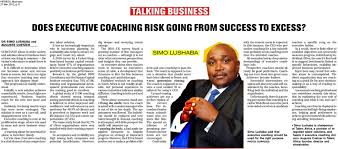Does Executive Coaching Risk Going From Success To Excess?
TALKING BUSINESS SUBSTANCE abuse in wider society and solution abuse in business have at least one thing in common — the victim's reluctance to admit there is a problem. It is difficult to determine when use becomes abuse and success leads to excess, but there are signs that leadership development and executive coaching may soon approach this slippery slope. The progression is readily understood.
Leadership Development and Coaching
Initially, a new solution achieves remarkable results. Great highs are experienced. Business leaders reach for the new tool more and more. Suddenly, it is being used in ways that were never envisaged. The solution is seen as a cure-all, until disappointment sets in. Executive coaching is now at the proliferation stage, where it is used in more and more business situations. A warning about the potential for abuse is therefore timely. Let's be clear. Leadership developmeny and executive coaching is a vital element of any comprehensive talent solution. It has an increasingly important role in succession planning.
Its availability also helps to attract, engage and retain key talent. A 2010 survey by a United Kingdom-based human capital consultancy found 97% of organisations believe executive coaching impacts positively on business performance. Research by the global DBM Consultancy and the Human Capital Institute revealed that 78% of HR, training and organisational development professionals rate executive training good or excellent. A global study of 2 100 coaching clients showed strong demand among potential clients as coaching is believed to drive improved selfconfidence and self-esteem (a core motivator for 40,9% of clients) and is perceived to improve work and life balance (35,5%) and career opportunities (27,6%). The same study found that 82,7% of client organisations were very satisfied with their coaching experience. So, acceptance and credibility are high among both companies and potential beneficiaries. However, dig deeper and worrying trends emerge. The 2010 UK survey found a growing number of line managers act as coaches — although it is not clear what extraneous perspectives and insights they can provide. As executive stress rises coaches work to increase an executive's sense of calm, a development that threatens to blur the line between coaching and psychotherapy. Published research on coaching in South Africa is not readily available, but personal experience in various industries indicates similar diffusion. Coaching is both used and abused. Three abuse scenarios stand out: fixing the misfit: here the coach is asked to fix a senior manager who is out of his or her depth. The appointment was flawed. The individual should be replaced and new talent brought in. Instead, coaching is attempted, with little prospect the misfit will measure up; passing the buck: a bad apple (or apples) threatens to impede progress on strategy or important projects. However, the CEO or board prefers not to replace problem chits dren and uses coaching to pass the t buck.
The coach is supposed to rescue a situation that should never have been allowed to fester; and next generation cloning: The coach is supposed to ensure a neat comfort fit is r tailored for today's CEO. Up-and-coming achievers are not a ,: perfect replica of .1 the current ) boss. The in- cumbent leader wants subordiv nates who are more like him The special attributes of r promising performers one tier t down are not I encouraged. Conformity with the current norm is expected. 1 In this instance, the CEO who pre- € scribes coaching for a key subordinate probably needs coaching more € than the intended coachee. i All scenarios betray deep misun- ( derstandings of executive coach- i ing's role. s Prospective coachees should al- I ready be good performers. Coaching can turn them into great ones. t mg can turn tnem into great ones. Achievers become leaders. Successful interventions result in self-discovery and self-enablement by the coachee, benefiting both the individual and the organisation. Unfortunately, there is a growing perception that coaching is a rather ill-defined executive perk to be doled out when a candidate reaches a specific rung on the executive ladder. As a result, there is little effort to establish objectives and accurately measure progress, individual by individual. Often, the coach's first task is to suggest benchmarks linked to specific behaviours, enabling improved business performance. Input here may reveal that solution abuse is contemplated.
The client organisation may see coaching as a quick fix for poor decisionmaking or as a way of evading responsibility. A seasoned coaching professional can sometimes remedy this situation by explaining the true role of coaching and what it can and can't achieve. Coaching can then be deployed to groom potential high-flying employees, helping good performers to achieve great results while addressing derailing behaviours. Simo Lushaba is chairperson of Talent Africa, a provider of integrated talent solutions, and heads it executive coaching division. Auguste Coetzer is Talent Africa founder, director and shareholder. SI MO LUSHABA Simo Lushaba said that executive coaching should be used for the right purpose.

Executive Coaching
Signium Africa works with a network of independent coaches who specialise in various areas including business coaching, executive coaching, performance coaching, skills coaching and integral coaching.
Read MoreTop Executives
Signium Africa is a world-class company offering integrated talent solutions to clients nationally and in sub-Saharan Africa.
Read MoreLeadership Development
Depending on the scope and size of each coaching project we assemble a team that is best able and appropriately experienced to meet the unique needs of our clients.
Read MoreServices we offer:
- Board Strategy Facilitation
- Competency Modelling
- Leadership Development and Coaching
- Assessment of Human Capital
- Board Recruitment


